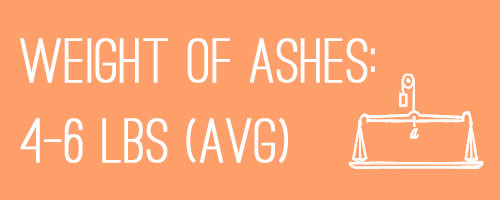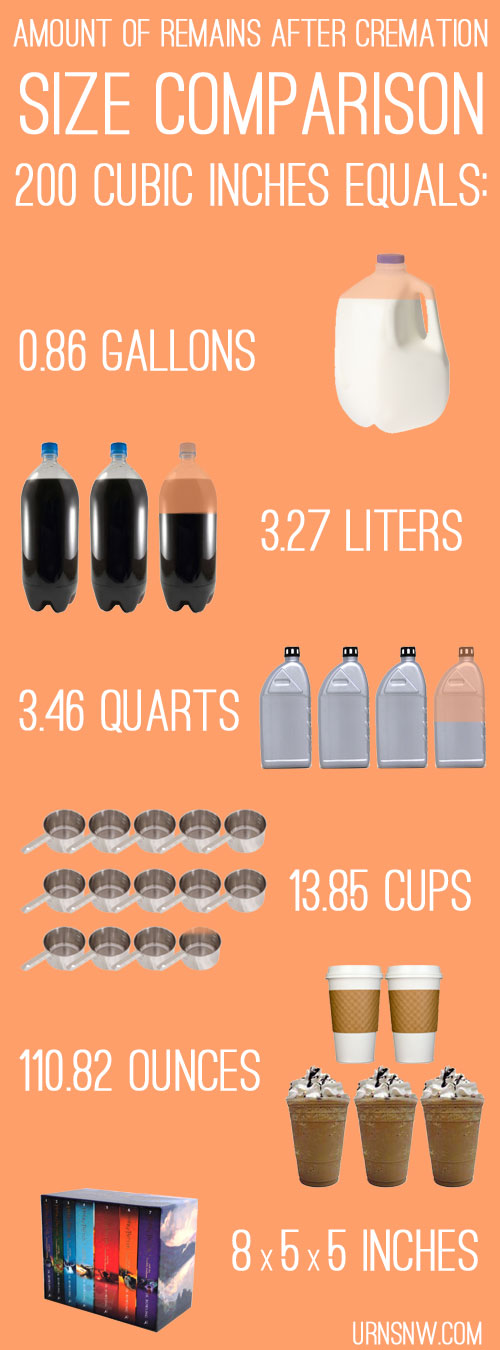How much ashes after cremation?
What amount of ashes will there be after cremation? And how do I find out what size cremation urn I will need?

This is one of the most common questions we receive - most people find the search engines auto-completing their question with some variation on "how much ashes after cremation."
We'll detail several ways to gauge the amount of ashes and how to determine what you'll need to look for to find the right size urn.
Cremated remains measurement standard
Most funeral industry metrics use cubic inches as the standard of measurement. A cubic inch refers to an area measuring 1" wide by 1" deep by 1" high.

While there are many variables to calculating the amount of ashes there will be after cremation, here is a simple rule of thumb: For every pound that the person weighed prior to cremation, there will be one cubic inch of cremated remains (i.e. ashes) after cremation.
For example, the remains of a man weighing 175 lbs will generally equal about 175 cubic inches.
Cremation urn measurement standard
Cremation urn capacity is also measured in cubic inches. Most standard adult urns have a capacity of 200 cubic inches, while "companion urns," which are designed for two people, generally have a capacity of 400 cubic inches.
Other sizes are also available depending on your needs: child, infant, pet, and sharing keepsake urns are several popular options that come in a range of sizes from 1 cubic inch up to 200 cubic inches.

TIP: Don't try to figure out how much an urn holds by the external measurements of the urn. Some urns have decorative overhangs, rounded edges, or other features that add size to the urn without expanding the capacity. Look on each product page for the dimensions to find the external measurements, but also look for the capacity, which will be listed using cubic inches. Learn more here.
Other factors that affect amount of ashes
As mentioned above, there are several considerations that may affect the amount of ashes resulting from cremation. Since organ tissue, skin, fat, and fluids are burned up during the cremation process, the "remains" or "ashes" will consist of bone material.
The greater the bone density, the more ashes there will be.
Here are some factors:
- Age - Younger people generally have greater bone density than elderly people.
- Gender - Men tend to have greater bone density than women.
- Height - The taller the person is, the more bone there will be.

Overall, the simple formula of 1 lbs body weight to 1 cubic inch of remains is the simplest method to get an accurate gauge of how much remains there will be after cremation. If the person is extremely thin or overweight, using a "healthy body weight" chart will help you get a pretty accurate idea of the amount of ashes.
See our urn size calculator for a simple estimation, as well as more detailed charts that calculate the cubic inches needed based on gender, body frame/type, and healthy weight.
If you already have the remains
Simply measure the length, depth, and height of the container holding the remains, then multiply the sides together to get the total cubic inches.

For example, a typical size for a "temporary urn" (cardboard or plastic box received from the funeral home) is 8.25" x 6.25" x 4.25".
Multiply these numbers together, and you'll see that the plastic or cardboard container holds a maximum of 219.14 cubic inches (less if you subtract the thickness of the container itself, as well as the plastic bag inside that actually holds the remains).
So if you have the remains in a box like this, just about any standard sized 200 cubic inch urn will work just fine.
Cremated remains weight
Typically, the remains from an average adult will weigh about 4-8 pounds. The ashes from a woman average around 4-6 lbs, while men average 6-8 lbs.
As with anything involving the human body, it can vary. Sometimes the weight of the remains can as little as 3 lbs, or as much as 10, depending on the person's height, bone density, etc.

Cubic inches comparisons
Here are a few ways to compare what 200 cubic inches looks like.
- Gallons - 200 cubic inches equals 0.86 gallons. This is a little less than a typical jug of milk.
- Liters - 200 cubic inches equals 3.27 liters. This is similar to a 2 liter of soda, plus a "personal" size 1 liter bottle.
- Quarts - 200 cubic inches equals 3.46 quarts. Think 3 standard bottles of motor oil, plus a half.
- Cups - 200 cubic inches equals 13.85 cups. This is like a medium-sized crock pot not quite full.
- Ounces - 200 cubic inches equals 110.82 fluid ounces. This is like a Starbucks run consisting of 5 "venti" sized drinks, 2 hot and 3 cold.
- Inches - 200 cubic inches equals a box 8" long by 5" wide and 5" deep. This is a little smaller than a boxed set of Harry Potter paperback books.

Keep learning about ashes & urns
Here are more great resources:
- What a cremation ashes made of?
- Urn Sizes: What You Need to Know to Choose the Right Cremation Urn
- What To Do With Cremated Remains: A 5 Minute Guide
If you're ready to start looking at memorial urns, here are the ones our customers say are the best of the best:
